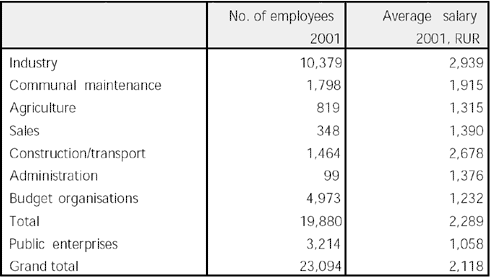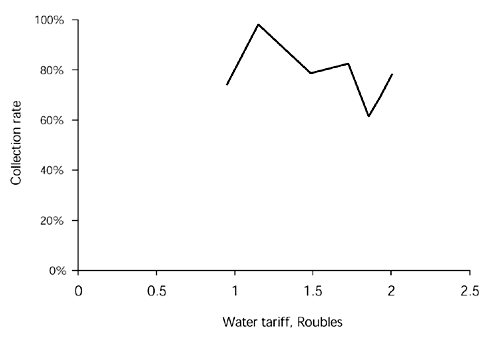Water Prices in CEE and CIS Countries. Volume II: Case Studies
Chapter 3.
Borovichi, Russia
Borovichi is a town with 60,000 inhabitants. In October 2001, Carl Bro Management was asked to test the Small Towns Toolkit, and as a basis for the test the project "Borovichi Drinking Water Project" was selected. Therefore, the material presented in this chapter is based on this test, supplemented by data collected by Kaliningrad Centre for Social Surveys.
Carl Bro Management collected the material within a short period of time - three days. This is enough time to get a grasp of the issues but, however, does not provide sufficient time to obtain the necessary understanding to determine whether an investment of significant size should be undertaken. The proposed resources in the Small Town Toolkit for such a study is in the order of six to eight weeks.
This chapter begins with a note on the technical baseline and is followed by an assessment of the willingness to pay and the affordability in Borovichi.
3.1 Technical baselineThe Borovichi Drinking water Project aims at evaluating the feasibility of converting the water supply from surface water to groundwater for Borovichi City. The necessary size of tariffs will be covered in the financial sections of the feasibility study. Therefore, Carl Bro Managemant has not investigated the size of future operational and maintenance cost as well as financial cost in the study.
The current tariff is 2.01 RUR per M3 and the norm is 320 litres per day per capita. Most households are not metered, but the metered households consume typically between 150 and 200 litres per day per household member.
The main sponsors have not yet been identified. DANCEE will probably be one of these and Russian Public Funds will be another. For DANCEE the main focus will be financial feasibility, environmental improvements and improved health conditions. This is already stated in the Inception Report. Other funding organisations will, in general, focus on the same issues, including the sustainability of the project. Own ability to pay for the operational costs in the future will have high priority, also seen in the light of a policy of removing cross subsidising.
3.2 Willingness to payIn the survey Poll Interviewing of heads of households in the city of Borovich implemented in October 2001 by Carl Bro Management and The Kaliningrad Centre for Social Surveys, one of the issues was water and wastewater service problems.
Among the respondents, 77% indicated that the quality of cold water is not high enough. This is due to dirt and chlorination (although the water is not chlorinated). Pressure is found to low among 61% of the respondents.
The general impression is that water is very cheap, also when compared with other tariffs. Almost half, 46%, of the respondents were willing pay for water services if the cold water supply could be improved, while almost a third, 29%, were indecisive. Hence a fourth of the respondents are not willing to pay more for water services. However, no information on the level of willingness to pay is available.
The respondents’ estimations of the water quality are presented below.
Table 3.1:
Opinion on Cold water quality

Source: Kaliningrad Centre for Social Surveys.
Only 23% of the interviewees drink water directly from the tap.
3.3 Affordability analysisIn order to evaluate affordability among the inhabitants, an affordability analysis was carried out based on the following information:
| General income data; | |
| Interview with Borovichi City Administration; | |
| Interviews with customers; | |
| Observations of goods and prices in Borovichi. |
The conclusion reached is that there does not appear to be a problem of affordability in Borovichi with the current level of tariffs. However, the Department for social affairs in Borovichi City Administration gave the impression that Borovichi is a poor society without much ability to meet increased tariffs.
3.3.1 General income dataIn Borovichi, roughly 60% of the population of working age are employed/work. Income data for employees are given in the table below.
Table 3.2:
Income among employees in Borovichi, by sector

Note: The data is from the first nine months in 2001.
Source: Carl Bro Management and Federal Statistic department in Borovichi
The average level of income is lower for the total population as employees generally have a higher income than students, unemployed and unregistered workers. However, income data was not available for these groups.
The minimum income level is RUR 1,075 and 4,388 persons fall into this category.
With the current water tariff and norm, a typical inhabitant in Borovichi pays approximately 19 RUR/month . Hence, for those persons living within the minimum income level, water tariffs account for approximately 2% of their income, and for the average employee, making 2,100 RUR per month, the cost for water services is around 1%.
3.3.2 Tariff increases and collection ratesIn Borovichi, during the past, there have been many increases in tariffs. One way to test affordability is to compare the increases in tariffs with the collection rate, the hypothesis being that problems of affordability will result in a decrease in the collection rate each time there is an increase in tariffs.
In Figure 3.1 we show the results of six previous increases in tariffs together with changes in collection rates. The observations cover the period from January 1999 to November 2001.

Figure 3.1:
Water tariff and collection rates, January 1999 to November 2001
Source: Carl Bro Management
Of the six increases, only two show a decrease in the collection rate. A preliminary conclusion is that the collection rate is not correlated with the changes made in the past two years, which leaves no indication of affordability problems.
3.3.3 Interview the Borovichi City AdministrationIn order to obtain information on the general income level and inhabitants' ability to afford an increase in tariffs, the Department for Social Affairs in Borovichi City Administration was interviewed.
The department organises all social programs in Borovichi and administrates social assistance programs. In addition, the department provides statistical information on income level for various groups, number of families receiving social assistance.
The Department for social affairs gave the impression that Borovichi is a comparatively poor society without much ability to meet increased tariffs. This contrasts with the results found elsewhere.
3.3.4 Interviews with customersTo investigate the level of affordability further, Carl Bro Management selected six families and analysed their patterns of consumption. The level of income for the families varies between 2,500 to 9,000 RUR per month and their size ranges from two to four. As such this provides a typical sample of the population in Borovichi.
The interviews indicated a certain ability to pay. Hence, it does not seem that there are affordability problems for typical households.
3.3.5 Observations of goods and prices in BorovichiIn order to assess the level of goods and prices in the shops, observations made in Borovichi, in November 2001, are shown in Table 3.3.
Shops were entered and the assortment evaluated for prices, quality and necessity in the main part of the city. The assessment is subjective and can as such only be used as support to the statistical information already described.
Table 3.3:
Observations of good and prices in Borovichi

Source: Carl Bro Management